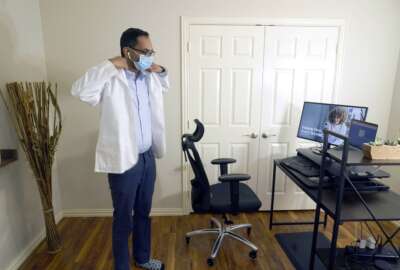
At the Health Resources and Services Administration, all system are go when it comes to telehealth
Whether it was used during the height of the pandemic, or if it is used now because of its convenience, telehealth has become a mainstay in the healthcare field...
Best listening experience is on Chrome, Firefox or Safari. Subscribe to Federal Drive’s daily audio interviews on Apple Podcasts or PodcastOne.
Whether it was used during the height of the pandemic, or if it is used now because of its convenience, telehealth has become a mainstay in the healthcare field. The Health Resources and Services Administration, an agency of the Department of Health and Human Services, is trying to spread the word about its resources available to help people understand telehealth and the implications of using it. For more, Eric White from the Federal Drive with Tom Temin spoke with the Director for the Office for the Advancement of Telehealth at HRSA, Heather Dimeris.
Heather Dimeris: So across the board, we saw telehealth increase by far because that’s how everybody needed to access their care for the most part, but of all those telehealth services, behavioral telehealth services were the ones that were tapped into the most. And so you can find a lot of that information on telehealth.hhs.gov on how you can get a telebehavioral health appointment and what you could do to prep for it. But looking at what types of behavioral health care you can get, it really varies. A lot of people experienced anxiety and depression throughout the pandemic. So you can get services for that and therapy for that you could also get mental health screening, and even addiction counseling. We did see that there was a 50% increase in psychiatric appointments through telebehavioral health, as well as substance abuse treatment through telebehavioral health; [that] was at about 30% throughout the pandemic. So this continues to be a really great resource for people, even as we’re going back to the doctor in person and doing telehealth visits. It’s sort of like an integrated standard of care where you can do either telehealth or in person.
Eric White: And other than spreading the word doing interviews like this one, what else is HRSA doing to help people get connected via telehealth? I’m sure there have been some technical hiccups that you all are also in the works of fixing for most people who aren’t as savvy as others. What can you tell me about that?
Heather Dimeris: Sure. Well, the Department of Health and Human Services and the Health Resources and Services Administration has a website telehealth@hhs.gov. It has information for patients around a lot of different ways they can use telehealth and access telehealth. And there’s also a door for providers where if there’s anyone in your audience that does provide health care, it has tip sheets and best practice guides across a variety of different areas that they’re looking to incorporate telehealth into their practice. And that includes chronic conditions, behavioral health, direct consumer care, and for those in your audience who speak Spanish, we really are trying to reach everybody in sharing this information. So the whole entire website is translated in Spanish as well.
Eric White: For Medicare and Medicaid recipients, can you just expand a little bit about how telehealth has changed the experience for those folks? And since we said that telehealth is here to stay, making telehealth a permanent fixture for Medicare, I imagine is going to be a bigger undertaking.
Heather Dimeris: That’s a great important point. And we have all used telehealth and there have been so many flexibilities that allowed that to take place over the pandemic. And what we’ve seen now is all of that data, all of the experiences that have taken place throughout the pandemic, we’re looking at it and we’ve already seen that within the Department of Health and Human Services at the Center for Medicare and Medicaid Services, they’re taking that information and they’re making changes. So for example, with telebehavioral health care, you can now as a provider get reimbursed for telebehavioral health services not just during the pandemic, but that they made that a permanent Medicare reimbursement now. And even more important, I think, is for people who don’t have access to broadband as a patient, and they’re looking to get a telebehavioral health appointment. They’re able to reimburse in Medicare the provider if the provider just needs to use a telephone. So if the patient can’t do that video chat — like we would all usually prefer to see people in person or via video chat — you can also have that appointment over the phone and the doctor can still get reimbursed for it. So I think CMS is making changes to Medicare permanently. And that’s one example of what they’ve done to take that data and then make changes moving forward.
Eric White: So I imagine behavioral health has seen a large increase in its use in telehealth; is that the biggest area where you all have seen telehealth patients use it the most?
Heather Dimeris: Yeah, throughout all the telehealth services, telebehavioral health is the most utilized service and actually on telehealth.hhs.gov, that is the most viewed portion of the website. And it’s really great to see because it really has been such an emotional experience for many of us. Throughout the pandemic, there has been a lot of changes and to see people tapping in to therapy services to help their own mental health needs is really great. And being able to provide that within the comfort of their own home, possibly even without the stigma of going into an office to get that therapy service, it really helps improve access to care and improve health equity.
Eric White: Yeah, on that health equity point, are we kind of on the precipice of seeing a lot of health equity or seeing the, I guess, a lot of health inequity be erased almost by this advent of telehealth, and maybe it could be one of the only positive aspects that come out of the pandemic itself?
Heather Dimeris: Well, telehealth, in my opinion, is a silver lining of the pandemic. We’ve seen a way to increase access to telehealth services and just health care services more broadly. I will say that the foundation of telehealth services is access to high speed internet or broadband. If you don’t have that you really can’t do those video chats that I was talking about in order to have a better experience in your telehealth appointment. And that’s why I want to mention on telehealth.hhs.gov, through the affordable connectivity program, there is information about how people who can’t afford high speed internet access like broadband services can qualify for the affordable connectivity program to get free monthly broadband service if they already receive other federal benefits, like the SNAP program or the WIC program, even if they receive a Pell Grant. There’s a variety of different federal benefits that if they already received them, they would automatically qualify for the affordable connectivity program. So I really would encourage folks to bridge that gap in broadband access by going to telehealth@hhs.gov to learn a little bit more about that program, because it will improve that telehealth experience that they need to have it.
Eric White: Yeah. Did you ever in your career in health administration? Did you see yourself having to be so technical nowadays with having to increase the amount of people who have access to broadband as your number one task nowadays?
Tom Temin: Well, HHS really hasn’t received any funding to work on broadband for telehealth services until we ended up looking at rural communities and their bandwidth and broadband throughout the pandemic. And that really is one of the things that’s difficult for rural communities, is making sure they have access to some type of high speed internet, whether it’s broadband or something called low Earth orbiting satellites, to your point about learning a lot of technology I didn’t otherwise know before. But I do think that it’s a great opportunity for us to also highlight in urban areas, sometimes there is access to broadband, but it’s not affordable. And so there’s there’s a little bit of an equity gap both in geographic as well as affordability needs when it comes to access to broadband. I would encourage folks to go to telehealth.hhs.gov as the pandemic evolves and the resources around telehealth evolve. That is where patients and providers can find the latest information about telehealth as it changes. And I just really want to thank you for your time to highlight this really important issue especially around behavioral health.
Copyright © 2024 Federal News Network. All rights reserved. This website is not intended for users located within the European Economic Area.
Tom Temin is host of the Federal Drive and has been providing insight on federal technology and management issues for more than 30 years.
Follow @tteminWFED




